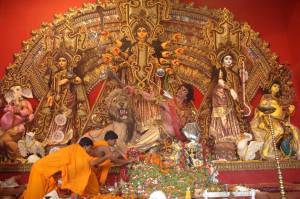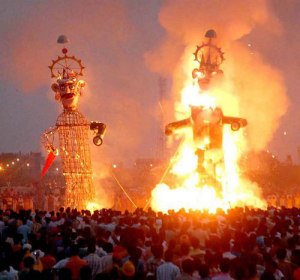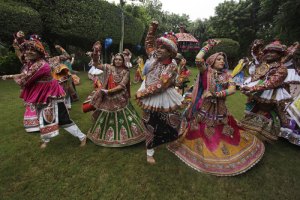Diverse ways of celebrating Navaratri in a diverse India
Navaratri is a festival dedicated to the worship of the Hindu deity Durga. The word Navaratri means ‘nine nights’ in Sanskrit nava meaning nine and ratri meaning nights. During these nine nights and ten days, nine forms of Shakti/Devi are worshiped. The tenth day is commonly referred to as Vijayadashami or “Dussehra” (also spelled Dasara). Navaratri represents a celebration of the Goddess Amba, (the Power) and is celebrated in a large number of Indian communities. The mother goddess is said to appear in 9 forms, and each one is worshiped for a day. These nine forms signify various traits that the goddess influences us with. The Devi Mahatmya and other texts invoking the Goddess who vanquished demons are cited. Diwali the festival of lights is celebrated twenty days after Dussehra. During this vowed religious observance, a pot is installed (ghatasthapana) at a sanctified place at home. A lamp is kept lit in the pot for nine days. The pot symbolizes the universe. The uninterrupted lit lamp is the medium through which we worship the effulgent Adishakti, i.e. Sree Durgadevi. During Navaratri, the principle of Sree Durgadevi is more active in the atmosphere. This festival corresponds to a nine-day Taoist celebration beginning on the eve of 9th lunar month of the Chinese calendar, which is observed primarily by the ethnic Chinese of Min Nan linguistic group in Southeast Asian countries like Myanmar, Singapore, Malaysia, Thailand and also the Riau Islands called the Nine Emperor Gods Festival.
The beginning of spring and the beginning of autumn are considered to be important junctions of climatic and solar influences. These two periods are taken as sacred opportunities for the worship of the Divine Mother Durga. The dates of the festival are determined according to the lunar calendar. Navaratri is celebrated five times a year. They are Vasanta Navaratri, Ashadha Navaratri, the Sharad Navaratri, and the Paush/Magha Navaratri. Of these, the Sharad Navaratri of the month of Puratashi and the Vasanta Navaratri of the Vasanta kala are the most important. Other two are observed by Shaktas only. The Chaitra Navaratri culminates in Ram Navami and the Sharad Navaratri culminates in Durga Puja and Dussehra.
North India
Navaratri is celebrated in different ways throughout India. In North India, all three Navaratri are celebrated with much fervor by fasting on all nine days and worshiping the Mother Goddess in her different forms. The Dussehra of Kullu in Himachal Pradesh is particularly famous in the North. In North India, as the culmination of the Ramlila which is enacted ceremoniously during Dussehra, the effigies of Ravana, Kumbhakarna, and Meghanada are burnt to celebrate the victory of good (Rama) over evil forces on the ‘Vijaya Dashami’ day.
Eastern India
The last four days of Sharad Navaratri take on a particularly dramatic form in the states of West Bengal and Odisha in Eastern India where they are c elebrated as Durga Puja. Eighth day is traditionally Durgashtami which is big in Bengal, Odisha and Bihar. This is the biggest festival of the year in these states. Exquisitely crafted and decorated life-size clay idols of the Goddess Durga depicting her slaying the demon Mahishasura are set up in temples and other places. These idols are then worshiped for five days and immersed in the river on the fifth day.
elebrated as Durga Puja. Eighth day is traditionally Durgashtami which is big in Bengal, Odisha and Bihar. This is the biggest festival of the year in these states. Exquisitely crafted and decorated life-size clay idols of the Goddess Durga depicting her slaying the demon Mahishasura are set up in temples and other places. These idols are then worshiped for five days and immersed in the river on the fifth day.
Western India
In Western India, particularly in the state of Gujarat and Mumbai, Navaratri is celebrated with the famous Garba and Dandiya-Raas dance. Since the past few years, the Government of Gujarat has been organising the “Navaratri Festival Celebrations” on a regular basis for the nine days of Navaratri Festival in Gujarat. People from all over Gujarat and even abroad come to participate in the nine days celebrations. It is also popular throughout India and among Indian communities around the world including the UK, Canada, Malaysia, Singapore and USA.
In the temples of Goa, on the first day of the seventh month of the Hindu calendar Ashwin, in some temples, a copper pitcher is installed surrounded by clay in which nine varieties of food grains are sown inside the sanctum sanctuary of the temple. All the nine nights are celebrated by presenting devotional songs, and through religious discourses. Later in the night the idol of the goddess is put in a specially-decorated colorful swing and for nine nights, this swing is being swung to the tune of temple music (called as ranavadya) by devotees who throng in large numbers to participate in the festival.
South India
In South India, people set up steps and place idols on them. This is known as golu. Photos of typical golu displayed in Tamil Nadu style can be found here.
In Karnataka, Ayudha Puja, the ninth day of Mysore Dasara, is celebrated with the worship of implements used in daily life such as computers, books, vehicles, or kitchen tools. The effort to see the divine in the tools and objects one uses in daily life is central to this celebration, so it includes all tools that help one earn one’s livelihood. Knowledge workers go for books, pen or computers, farmers go for the plough and other agricultural tools, machinery for industrialists and cars/buses/trucks for the transportation workers all are decorated with flowers and worshiped on this day invoking God’s blessing for success in coming years. It is believed that any new venture such as starting of business or purchasing of new household items on this day is bound to bring success and prosperity.
Mysore is well known for the festivities that take place during the period of Dasara, the state festival of Karnataka. The Dasara festivities, which are celebrated over a ten-day period, made official festival of the state by Raja Wodeyar I in 1610. On the ninth day of Dasara, called Mahanavami, the royal sword is worshipped and is taken on a procession of decorated elephants, camels and horses. On the tenth day, called Vijayadashami, the traditional Dasara procession (locally known as Jumboo Savari) is held on the streets of Mysore. An image of the Goddess Chamundeshwari is placed on a golden howdah on the back of a decorated elephant and taken on a procession, accompanied by tableaux, dance groups, music bands, decorated elephants, horses and camels.[5] The procession starts from the Mysore Palace and culminates at a place called Bannimantapa, where the banni tree (Prosopis spicigera) is worshipped. The Dasara festivities culminate on the night of Vijayadashami with a torchlight parade, known locally as Panjina Kavayatthu.
In Kerala and some parts of Karnataka, Ashtami, Navami, and Vijaya Dashami of Sharad Navarathri are celebrated as Sarasvati Puja in which books are worshiped. The books are placed for Puja on the Ashtami day in their own houses, traditional nursery schools, or in temples. On Vijaya Dashami day, the books are ceremoniously taken out for reading and writing after worshiping Sarasvati. Vijaya Dashami day is considered auspicious for initiating the children into writing and reading, which is called Vidyarambham. Tens of thousands of children are initiated into the world of letters on this day in Kerala.
In Telangana region of Andhra Pradesh, people c elebrate Bathukamma festival over a period of nine days. It is a kind of Navaratri celebration. Here Navaratri is divided into sets of three days to adore three different aspects of the supreme goddess or goddesses.
elebrate Bathukamma festival over a period of nine days. It is a kind of Navaratri celebration. Here Navaratri is divided into sets of three days to adore three different aspects of the supreme goddess or goddesses.
First three days: The goddess is separated a spiritual force called Durga also known as Kali in order to destroy all our evil and grant boons.
Second three days: The Mother is adored as a giver of spiritual wealth, Lakshmi, who is considered to have the power of bestowing on her devotees inexhaustible wealth, as she is the goddess of wealth.
Last three days: The final set of three days is spent in worshiping the goddess of wisdom, Saraswati. In order to have all-round success in life, believers seek the blessings of all three aspects of the divine femininity, hence the nine nights of worship. During the eighth or ninth day, Kanya Puja, pre-pubescent girls are ceremonially worshipped. On the 10th day, the effigy of Ravana is burnt
In some parts of South India, Saraswati puja is performed on the 9th day. Ayudha Puja is conducted in many parts of South India on the Mahanavami (Ninth) day with much fanfare. Weapons, agricultural implements, all kinds of tools, equipment, machinery and automobiles are decorated and worshipped on this day along with the worship of Goddess. The work starts afresh from the next day, i.e. the 10th day which is celebrated as ‘Vijaya Dashami’. Many teachers/schools in south India start teaching Kindergarten children from that day onwards.
During Navaratri, some devotees of Durga observe a fast and prayers are offered for the protection of health and prosperity. Devotees avoid meat, alcoholic drinks, grains, wheat and onion during this fast. Grains are usually avoided since it is believed that during the period of Navaratri and seasonal change, grains attract and absorb lots of negative energies from the surrounding and therefore there is a need to avoid eating anything which is produced from grains for the purification of Navaratri to be successful. Navaratri is also a period of introspection and purification, and is traditionally an auspicious and religious time for starting new ventures.

nice post, i loved it. Want to experience this once in my lifetime.
Awesome article about Navaratri